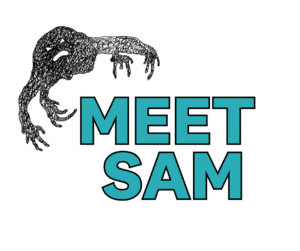Children’s Authors and Illustrators Week is celebrated the entire month of February here at SAFE Project! Our second interview for 2024 is with Rosi Greenberg, author of Everyone Has a Sam:

Who is Rosi Greenberg?
My name is Rosi Greenberg. I am a leadership development artist. For the past 15 years, I have been helping people discover themselves and connect more deeply with others. Presently, my focus is on the inner critic, and I aim to assist people in overcoming the negative inner voices that we all encounter.
Working With SAFE Project
SAFE Project is one of my favorite groups to work with! The first time I presented Everyone Has a Sam was at one of the CRLA events a couple of years ago, and I’ve presented at CRLA every year since then. I’ve also held leadership development sessions with the SAFE Project team.

Sam is my inner critic! He’s like a little goon that sits on my head and criticizes me. I created him as a character one day and asked him what his name was. When I heard the name, Sam, I immediately thought it was a dumb name and wondered why I couldn’t develop anything more creative. That’s when I realized that the negative inner voice itself was Sam.
The inner critic or impostor syndrome is this negative voice inside of us that is constantly telling us things like, “You’re not doing this right. You’re failing. You’re lazy, you’re stupid.” All of these little things, and we sometimes don’t even articulate it, we hear it as truth. All of these thoughts about ourselves and in comparison with others, this kind of almost contempt that we put inwards towards ourselves is what I call the inner critic or impostor syndrome.
The Sam Exercise
I began drawing a character named Sam for myself. When I first saw him on paper, I realized that he was a distinct, critical part of myself. I drew Sam along with all the things he says to me in different situations. I even drew a page where I was eating, showering, biking, and working while Sam was saying things to me. As I was drawing, I could hear the negative things Sam was saying to me, such as, “This drawing is stupid,” “You look like you’re wearing a leotard,” “Nobody wears leotards,” “This isn’t even what I say,” and “You’re getting this wrong.” I started writing down every negative thing Sam said to me, which eventually became part of the book.
It became more fodder. So I was winning either way. I was winning just by drawing the things he said. And then as he was saying more mean things, I was like, ha, I’m going to write that one down. And I felt so powerful in that moment because there was nothing he could say to me that could get me. After all, I was just going to make art out of all of it.
Different “Sams”
Some of them look exactly like my Sam. Some have been hands just grasping the person or a broken mirror. There are so many — one like a toolbox, amazing monsters… I don’t even want to say my “favorites” because it’s my favorite thing when people draw theirs and it comes out exactly the way it should look for them. It’s amazing to see the variety of shapes and forms that they take.
Reframing
Everybody told me your mess is your message, meaning the things that you go through and the ways that you respond to them are part of what you have to offer the world. And when I was in my darkest moments, at first I didn’t believe that was true. In my darkest moments when people were saying that to me, I was like, that is not true. I didn’t believe that this experience was meant to be a message or anything like that.
However, I realized that once I accepted it as a part of my journey, I was able to see it for what it truly was. Instead of fighting against it and trying to get rid of it, I started incorporating it into my life story. I believe that for anyone going through a tough time, that experience is a part of their life story and can provide them with wisdom.
The Inner Critic and Young Children

My book is primarily for adults but can be easily accessible to children as well. It can help parents and educators have conversations with children about negative inner voices and provide them with the language to identify and deal with them. The goal is to empower children to draw on resources to counter their inner meanie and be kind to themselves and others.
Thank you to Rosi for sharing her stories and experiences. Learn more at lovethatmess.com.
